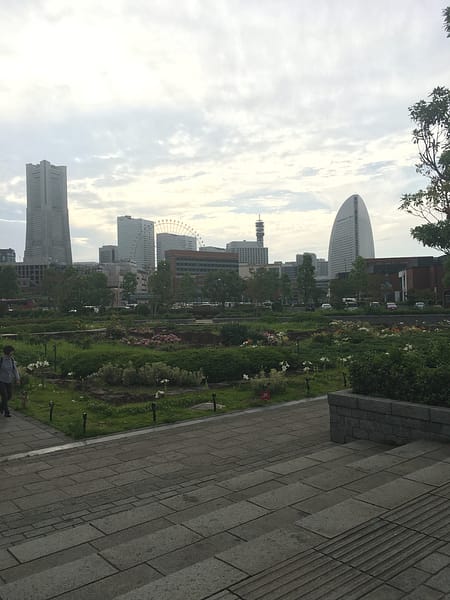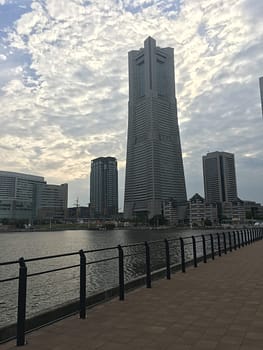The traveler sees what he sees. The tourist sees what he has come to see. – G.K. Chesterton
It’s no secret that Husband and I do our best to get out of the house as often as we can. When we first moved here, we were told “In three years, you can go out every weekend and not see all there is to see. You can go out every day and not see all there is.”
Challenge accepted.
Just kidding (sort of). Although some days we’d rather stay home (and we do), we make a point to get out and about as often as we can. Even a small day trip can yield an awesome adventure. One of our repeat visits has been to Yokohama, Japan. Yokohama was Japan’s first port city, opening its doors to global trade in 1859. Just south of Tokyo, it’s the second-largest city in the country. For us, Yokohama is a short train ride away, making it easily accessible with a lot to offer.
We’ve visited Yokohama a few times since we arrived in Japan. Although we’re just beginning to scratch the surface of all the amazing things the city has to offer, I wanted to share with you a few fun things we’ve done. In no particular order, here are 6 must-see spots in Yokohama.
Landmark Tower
This was our very first stop in the city at the recommendation of friends. With the highest observation deck in Yokohama, Landmark Tower offers a great view of the city. Although we haven’t been there at night, we’ve been told the view is especially nice.
It costs about 1,000 yen to get to the observation deck on the 69th floor. To access the deck, visitors ride an elevator traveling at a whopping 750m/min. Currently, the elevator is the Guinness World Record holder for the fastest passenger lift in Japan, delivering you to the top in a mere 40 seconds.
At the top, there’s a small gift shop and the Sky Garden Café. Along with an amazing view, the café offers a limited menu of food, cocktails, wine, and beer. Before you wrap up your time around the tower, make sure to head to the mall area underneath the tower. There’s a wide range of shops and food, perfect for any style.
Yamashita Park
Yamashita Park wasn’t on my radar at all until I asked a local expat group for recommendations on where to see some fall leaves. I was a little too early in the season for the color change, but Yamashita didn’t disappoint. Opened in 1930 as the first seaside park in Japan, it’s a great place to head for an afternoon stroll or family picnic.
Docked at the entrance to the park is the Haikawa Maru, an ocean liner used to transport passengers and cargo from Japan to Seattle. The boat is open to visitors, although I didn’t have a chance to go in during my short visit. The park’s entrance also houses the Guardian of the Water statue. Modeled after the original in San Diego, Yokohama’s sister city, it was given as a gift in 1960.
Yamashita park has many things to offer, including flower gardens at one end of its 700-meter length. Oftentimes you can find street performers outside the restaurant and café at the other end. Not to mention the view over the water is beautiful! The sound of seagulls gives you that “at the beach” feel without all the sand. I highly recommend making a stop the next time you’re in Yokohama.
Chinatown
Just a few blocks down from Yamashita Park is Yokohama’s Chinatown. As the largest Chinatown in Japan, the area now hosts more businesses than actual residents. There are four gates marking the entrances to Chinatown from the four directions. Five more gates can be found within the area.
I arrived in Chinatown as a solo traveler late in the day, so I didn’t explore as much as I would have liked to. I mostly stuck to the main road, which was hugely crowded. One website said the area is 250,000 sq meters. Although that may not seem very big, a lot is packed in! There were so many side roads that beckoned me to explore, but unfortunately, time didn’t allow.
In the center of Chinatown is the Kanteibyo Shrine. Originally, it was an anchor to Chinese culture for the area residents. Now, it beckons to Feng Shui enthusiasts and business owners. Exploring Chinatown can easily take up half a day, especially if you hope to eat in multiple places. If you’d like to plan ahead, check out this website for a list of shops and restaurants.
Red Brick Warehouse
I first heard about the Red Brick Warehouse during our Japanese Headstart class when we first arrived in the country. Originally, the warehouse served as the port’s customs inspection house. After briefly functioning as the US military harbor headquarters after World War II, the Warehouses were converted into a commercial space. After nine years of restoration work, they officially opened for business in April 2002.
Between the two warehouse buildings, there are over 40 shops and restaurants. Husband and I have returned often for unique gifts to send to family and friends. The open space between the buildings is active and serves as an event space during different times of the year. During the winter, you can find the German-style Christmas market (read about our experience HERE). On the eve of 2019, the Red Brick Warehouse was the site of the finale for Japanese Ninja Warrior. During the summer, concerts and craft fairs entertain visitors and residents alike.
Of course, there are other shops and shopping areas around the Warehouse that are worth checking out. One of the more notable ones is Pie Holic. The original restaurant is in California and offers a wide range of pie-style foods. Ever had a taco with a pie crust shell? No? You should.
With so many unique shopping and cuisine options, Red Brick Warehouse should definitely be on your list of places to see while in town.
Ramen Museum
Another popular tourist spot is the Yokohama Ramen Museum. Husband and I heard about this early in our time here, but only recently went for a visit. The Ramen Museum is different than the Cup of Noodles Museum, which can be found in both Yokohama and Osaka. Founded in 1994, and the only one of its kind, the Ramen Museum was the world’s first food-themed amusement park. Bring your appetite; there’s lots to eat here!
Entrance into the museum is 300 yen, and each visitor is expected to purchase at least one bowl of ramen. The first floor is a museum area that offers insight into the history of ramen and the different types available. I found this very helpful in naming the kind of ramen that I like. Up until this point, I would order and then decided either “I like this” or “I don’t like this”. Although I knew if I liked it or not, I often didn’t know enough about what I was eating to choose stuff I like more often. The banners and displays explaining the different types of ramen were very helpful. This floor also has an education corner, a slot-car race track, and the museum shop.
After you peruse the entrance area, head downstairs to eat. The two basement floors are modeled after 1958 Tokyo, the year ramen really started to become popular. There are around 10 individual places to eat. Each has a ticket machine outside where you purchase your meal, and many of them have English menus available. Although some restaurants offer half-sized ramen bowls, some don’t. So if you’re thinking of having more than one bowl, come hungry!
Our visit started early in the day and we found ourselves finishing up around lunchtime. Unknown to us at the time, many salarymen seem to come to the museum for lunch. The lines can get really long around that time, so plan accordingly. This is a great stop to put on your itinerary!
Catch a game at Nissan Stadium
Last but not on the list – catch a sporting event at Nissan Stadium. I’ll admit, this was a last-minute addition to my list. But, I wouldn’t be my husband’s wife if I didn’t encourage you to stop by and catch a rugby game during your visit. We’ve seen the All Blacks play Australia here so far, and we’ll be back again for the Rugby World Cup Final in the fall. To date, this stadium has the highest seating capacity of any stadium in Japan. It’s well laid out and accessible from multiple train stations. Hosting music events, FIFA club world cup matches, and a slew of other good things, there’s something here for everyone. To check out the upcoming events, visit their website HERE.
As expected, we’ve only begun to scratch the surface of all that Yokohama has to offer. Thankfully, it’s close enough for a day trip, and we plan to visit often. What’s your favorite place on this list? Do you have other recommendations for things to see in Yokohama? Leave a comment below and let me know!
Until next time!





































